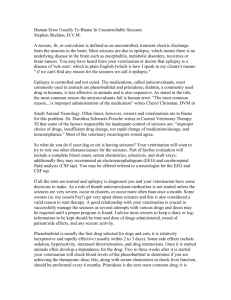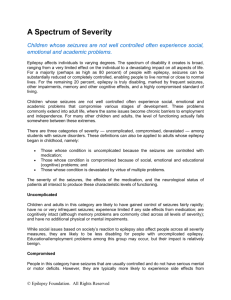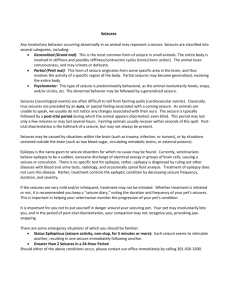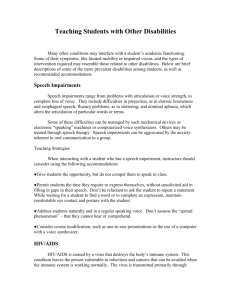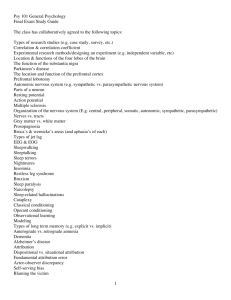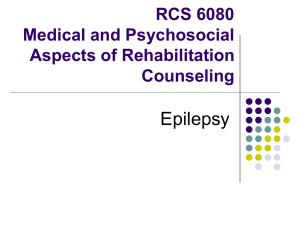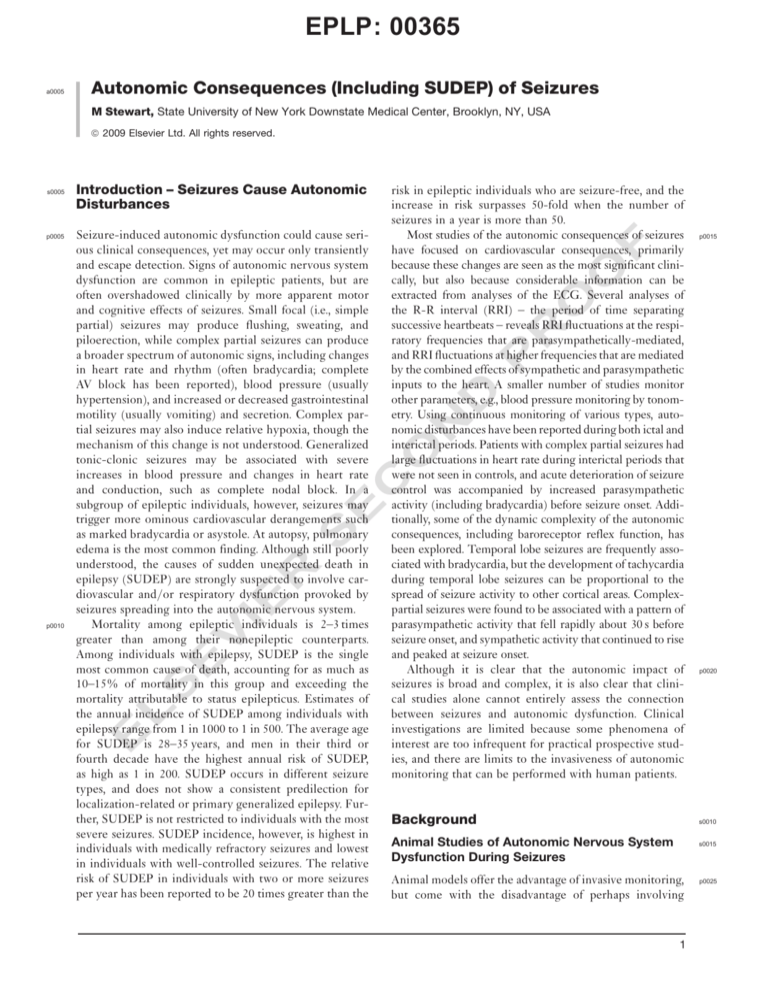
EPLP: 00365
a0005
Autonomic Consequences (Including SUDEP) of Seizures
M Stewart, State University of New York Downstate Medical Center, Brooklyn, NY, USA
ã 2009 Elsevier Ltd. All rights reserved.
Seizure-induced autonomic dysfunction could cause serious clinical consequences, yet may occur only transiently
and escape detection. Signs of autonomic nervous system
dysfunction are common in epileptic patients, but are
often overshadowed clinically by more apparent motor
and cognitive effects of seizures. Small focal (i.e., simple
partial) seizures may produce flushing, sweating, and
piloerection, while complex partial seizures can produce
a broader spectrum of autonomic signs, including changes
in heart rate and rhythm (often bradycardia; complete
AV block has been reported), blood pressure (usually
hypertension), and increased or decreased gastrointestinal
motility (usually vomiting) and secretion. Complex partial seizures may also induce relative hypoxia, though the
mechanism of this change is not understood. Generalized
tonic-clonic seizures may be associated with severe
increases in blood pressure and changes in heart rate
and conduction, such as complete nodal block. In a
subgroup of epileptic individuals, however, seizures may
trigger more ominous cardiovascular derangements such
as marked bradycardia or asystole. At autopsy, pulmonary
edema is the most common finding. Although still poorly
understood, the causes of sudden unexpected death in
epilepsy (SUDEP) are strongly suspected to involve cardiovascular and/or respiratory dysfunction provoked by
seizures spreading into the autonomic nervous system.
Mortality among epileptic individuals is 2–3 times
greater than among their nonepileptic counterparts.
Among individuals with epilepsy, SUDEP is the single
most common cause of death, accounting for as much as
10–15% of mortality in this group and exceeding the
mortality attributable to status epilepticus. Estimates of
the annual incidence of SUDEP among individuals with
epilepsy range from 1 in 1000 to 1 in 500. The average age
for SUDEP is 28–35 years, and men in their third or
fourth decade have the highest annual risk of SUDEP,
as high as 1 in 200. SUDEP occurs in different seizure
types, and does not show a consistent predilection for
localization-related or primary generalized epilepsy. Further, SUDEP is not restricted to individuals with the most
severe seizures. SUDEP incidence, however, is highest in
individuals with medically refractory seizures and lowest
in individuals with well-controlled seizures. The relative
risk of SUDEP in individuals with two or more seizures
per year has been reported to be 20 times greater than the
risk in epileptic individuals who are seizure-free, and the
increase in risk surpasses 50-fold when the number of
seizures in a year is more than 50.
Most studies of the autonomic consequences of seizures
have focused on cardiovascular consequences, primarily
because these changes are seen as the most significant clinically, but also because considerable information can be
extracted from analyses of the ECG. Several analyses of
the R-R interval (RRI) – the period of time separating
successive heartbeats – reveals RRI fluctuations at the respiratory frequencies that are parasympathetically-mediated,
and RRI fluctuations at higher frequencies that are mediated
by the combined effects of sympathetic and parasympathetic
inputs to the heart. A smaller number of studies monitor
other parameters, e.g., blood pressure monitoring by tonometry. Using continuous monitoring of various types, autonomic disturbances have been reported during both ictal and
interictal periods. Patients with complex partial seizures had
large fluctuations in heart rate during interictal periods that
were not seen in controls, and acute deterioration of seizure
control was accompanied by increased parasympathetic
activity (including bradycardia) before seizure onset. Additionally, some of the dynamic complexity of the autonomic
consequences, including baroreceptor reflex function, has
been explored. Temporal lobe seizures are frequently associated with bradycardia, but the development of tachycardia
during temporal lobe seizures can be proportional to the
spread of seizure activity to other cortical areas. Complexpartial seizures were found to be associated with a pattern of
parasympathetic activity that fell rapidly about 30 s before
seizure onset, and sympathetic activity that continued to rise
and peaked at seizure onset.
Although it is clear that the autonomic impact of
seizures is broad and complex, it is also clear that clinical studies alone cannot entirely assess the connection
between seizures and autonomic dysfunction. Clinical
investigations are limited because some phenomena of
interest are too infrequent for practical prospective studies, and there are limits to the invasiveness of autonomic
monitoring that can be performed with human patients.
p0015
E
p0010
L
S
E
V
IE
R
S
E
C
O
N
D
p0005
Introduction – Seizures Cause Autonomic
Disturbances
P
R
O
O
F
s0005
Background
p0020
s0010
Animal Studies of Autonomic Nervous System
Dysfunction During Seizures
s0015
Animal models offer the advantage of invasive monitoring,
but come with the disadvantage of perhaps involving
p0025
1
EPLP: 00365
E
L
S
E
V
IE
R
S
p0035
seizure activity unlike that in human epilepsy patients.
This disadvantage has been addressed principally by the
development of various animal models. Seizures have
been caused in different animal species (from rodents to
primates) by different means (such as electrical stimulation or chemical convulsants) in different parts of the
brain under different conditions (anesthetized or awake).
Seizure induction mechanisms fall into two broad categories: drugs or techniques that enhance excitatory synaptic transmission, and drugs or techniques that reduce
inhibitory synaptic transmission. High frequency trains
of electrical stimulus pulses can elicit a seizure if the
stimuli are large enough in amplitude and given for a
sufficient period. Kindling is a technique whereby trains
of relatively low amplitude electrical stimuli are repeatedly applied to a region of the brain. Initial stimulation
episodes may have no detectable effect, but after repeated presentations of stimuli, each presentation triggers
increasingly severe seizures. Chemical convulsants are
generally agonists (or modulators) for the glutamate
receptor or antagonists (or modulators) of the GABA
receptor. Kainic acid is an example of a convulsant that
is a glutamate receptor agonist. After a single systemic
dose, seizures recur for hours, and a chronic condition can
develop after weeks, during which seizures occur spontaneously. Kainic acid-induced seizures appear to begin in
the limbic cortices and have led investigators to consider
this approach as a model for temporal lobe epilepsy.
Most invasive monitoring is performed in acute
anesthetized animal experiments. Some anesthetics permit seizure activity and some abolish seizures. Pentobarbital is a potent anticonvulsant. The combination of
ketamine and xylazine permits seizure activity, including
motor convulsions. Urethane is interesting as an anesthetic because it permits limbic seizure activity, but not
neocortical seizure activity. The hemispherectomized rat
is used for acute studies without anesthesia. The entire
cortex is removed under short acting anesthesia, and the
anesthesia is stopped. In the absence of neo- and limbic
cortex, sensory perception and motor activity, including
motor convulsions, are abolished. Each animal model
offers access advantages for autonomic nervous system
studies that can be impossible to obtain when studying
patients. Some examples of autonomic consequences of
seizures are given here, and more details appear in the
listed readings.
Amygdala-kindled seizures in rats were found to activate both sympathetic and parasympathetic systems and
produced ictal hypertension and bradycardia that could
each be blocked pharmacologically. Left insular cortex
stimulation in rats produced an increasing degree of
heart block and resultant ventricular escape rhythms
that eventually resulted in asystole. In our own rat
model, left-sided limbic seizure activity was associated
p0040
with a more pronounced vagus nerve activity increase
and associated blood pressure decrease.
Systemic pentylenetetrazol seizures in cats were shown
to be associated with cardiac sympathetic and parasympathetic activity that was intermittently synchronized
with interictal spike activity (‘lockstep’ phenomenon).
Unstable lockstep periods, when interictal spikes and
synchronized autonomic activity occurred at irregular
intervals, were associated with large fluctuations in
blood pressure.
Focal penicillin-G application to the hypothalamus,
in hemispherectomized, unanesthetized rats, produced
bradyarrhythmias and a small decline in systolic blood
pressure. Creating an additional penicillin focus at the
mesencephalic level increased paroxysmal activity, and
produced severe conduction anomalies (including AV
block). Coactivation of hypothalamic and mesencephalic
centers by focal injection of penicillin often resulted in
death in rats.
Hypoventilation during status epilepticus, in a sheep
model of SUDEP, correlated strongly with seizureinduced death; the incidence of benign cardiac arrhythmias, catecholamine levels, seizure type and seizure
duration did not differ between animals that died and
animals that lived. Mice that exhibit audiogenic seizures
frequently display respiratory arrest that can be fatal –
and can be prevented by increasing the quantity of
oxygen in the environment.
E
C
O
N
D
p0030
Autonomic Consequences (Including SUDEP) of Seizures
P
R
O
O
F
2
p0045
p0050
p0055
Pathways for Spread of Seizures to the
Autonomic Nervous System (ANS)
s0020
Neocortex and limbic cortices are heavily connected with
structures that constitute the ANS, or with regions that
project into autonomic structures. The central nucleus of
the amygdala and bed nucleus of the stria terminalis are
major inputs to hypothalamic, pontine and medullary
structures that control preganglionic autonomic neurons
of both the sympathetic and parasympathetic branches
of the autonomic nervous system. They are positioned
to relay cortical activity into the ANS. Neocortex and
limbic cortices, especially subiculum, also have direct
projections to hypothalamus. Autonomic pathways are
integrated in the hypothalamus and influence all visceral
systems, including cardiovascular, genitourinary, endocrine, and digestive, as well as peripheral involuntary
muscles such as pilomotor and pupillary sphincters.
Projections of hypothalamic, including pontine and
medullary neurons to preganglionic parasympathetic and
sympathetic neurons controlling cardiac and respiratory
function, have been studied anatomically and physiologically. Hypothalamic cells project onto medullary structures (ventrolateral medulla and periaqueductal gray) that
project directly to sympathetic preganglionic cell bodies
p0060
p0065
EPLP: 00365
Autonomic Consequences (Including SUDEP) of Seizures
s0025
Our rat model for acute studies of autonomic consequences replicates many features of autonomic disturbances seen in epilepsy patients, and offers some unique
advantages. Using kainic acid as the convulsant drug on a
background of urethane anesthesia, we produce a prolonged period of recurring limbic seizures that do not
significantly involve the neocortex. As a result, animals
can be kept in a stereotaxic frame without paralytic
agents. The lack of motor convulsions permits stable
recordings from the brain, spinal cord, and peripheral
nerve, as well as accurate, invasive monitoring of systemic
parameters such as blood pressure. We have also developed a simple method for reversibly suppressing seizures
in one or both hemispheres repeatedly. The preparation
is described briefly here, and more details are given in
the readings.
We use male Sprague-Dawley albino rats for most
experiments. Six to 8 week old animals (200–350 g) are
commonly used. Animals are anesthetized with urethane
(1.5 g kg 1 ip), fitted with an endotracheal tube, and
maintained at 37 C. Blood pressure is monitored with
an intra-arterial line (polyethylene tubing, 0.5 mm id,
0.8 mm od, inserted into the femoral artery) and pressure
E
L
S
E
V
IE
R
p0080
Methods – Our Acute Rat Model
p0085
P
R
O
O
F
transducer. An increase in mean arterial pressure, systolic
or diastolic pressure (with no increase in pulse pressure)
indicates an increase in sympathetic vasoconstrictor tone.
Likewise, a decrease in blood pressure reflects a decrease
in sympathetic tone. Increases in pulse pressure reflect
increased cardiac stroke volume, which occurs physiologically through two mechanisms: At slow heart rates, stroke
volume increases through increased diastolic filling time.
At increased heart rates, increased stroke volume reflects
increased cardiac emptying from increased cardiac contractility produced by increased sympathetic input to the
cardiac muscle and increased circulating catecholamines.
ECG is recorded with parasternal electrodes. Heart
rate will increase in response to increased sympathetic
and/or decreased parasympathetic outflow to the heart.
Decreases in rate are mediated by decreased sympathetic
and/or increased parasympathetic outflow. Heart rate
changes can occur as a direct response to descending
inputs to sympathetic or parasympathetic preganglionic
neurons, or changes can be reflexively driven by baroreceptor activity. The presence of abnormally shaped
QRS complexes indicates ectopic beats (i.e., patterns of
contraction not following the typical conduction pathways). Rates are calculated from the number of beats per
unit time and rhythm is assessed by looking at P waves
and associated QRS complexes for variations in beatto-beat intervals and atrial-ventricular coupling. Successive R-R intervals will increase if the heart is under
predominant parasympathetic control. Successive R-R
interval decreases indicate relative sympathetic nervous
system control of the heart. An added benefit of using
anesthetized animals is that transthoracic echocardiography can be used to study the mechanical properties of the
heart during seizures. The force of contraction, filling
and emptying properties, and chamber sizes, are some of
the measurements that can be readily made in an echocardiographic study. Ultrasound probes are now quite
good for small animal imaging studies, even at the high
heart rates seen in mice or rats.
For peripheral nerve recordings, we use a linear array
electrode that consists of 4 platinum/iridium wires
embedded in a small epoxy trough. Wires pierce large
nerves as they lay in the trough. Smaller nerves (e.g., renal
nerve) are ‘woven’ between electrodes. Excellent multiunit recordings, occasional single unit recordings, and
even simultaneous stimulation and recording are possible
with this electrode. Vagus or cervical sympathetic electrodes are placed through a ventral neck incision. Renal
sympathetic nerve electrodes are placed through a retroperitoneal incision near the kidney. The renal sympathetic nerve contains postganglionic sympathetic fibers
to the renal vascular supply. Splanchnic nerve exposure
is also through a flank incision on the left side. Greater
splanchnic nerve recordings give access to sympathetic
p0090
E
C
O
N
D
p0075
S
p0070
located in the intermediolateral horn of the spinal cord.
Activity of hypothalamic and medullary neurons correlates with sympathetic nerve activity. Some hypothalamic
cells themselves project directly into the spinal cord.
For the parasympathetic system, central nuclei of the
amygdala and hypothalamus (PVN and SON) project
directly into the dorsal motor nucleus of the vagus and
the nucleus ambiguus, the sites of parasympathetic preganglionic cell bodies. Furthermore, the sympathetic and
parasympathetic paths can influence each other. For
example, efferents of the nucleus ambiguus and dorsal
nucleus of the vagus (preganglionic parasympathetic neurons) project to the nucleus of the solitary tract which
has a relayed projection to intermediolateral horn (sympathetic preganglionic neurons).
It is not surprising, then, that thalamic/hypothalamic
discharges elicited by penicillin-G application would be
associated with bursts of activity in vagus nerve recordings. We also found bursts of activity in vagus nerve
recordings during the slow spiking period at the end of
the limbic seizure, although the total amount of vagus
nerve activity at these times was much less than we
found earlier in each seizure episode. Interestingly,
while the types of seizures in these two animal models
are quite different, a pathway from hypothalamic areas
through the medulla and into the periphery is common,
and can account for similarities in vagus nerve discharge.
3
p0095
EPLP: 00365
p0105
L
S
E
V
IE
R
S
p0110
preganglionic fibers. Cardiac sympathetic nerves coming
off the stellate ganglion are exposed under the second rib
through a parasternal incision.
Baroreceptor reflex function is conveniently assessed
by recording peripheral autonomic nerve and systemic
parameter variations to bolus injections of a vasodilator
(e.g., sodium nitroprusside – 0.1 mg i.a.) or a vasoconstrictor (e.g., phenylephrine – 0.25 mg i.a.).
By using a stereotaxic frame, multiple electrodes can
be implanted for recording seizure activity from limbic
cortical structures. These electrodes are placed using stereotaxic coordinates through craniotomy holes. Depending
on the experiment, we use dorsal and/or ventral hippocampal electrode placements. Electrodes are generally
75 mm teflon-insulated stainless steel wires (tip impedances
100 kO). Typical stereotaxic coordinates for EEG electrodes are 5.2 mm anterior to lambda, 3 mm lateral to
midline, 2–3 mm below skull surface (dorsal CA1); and
2.7 mm anterior to lambda, 5 mm lateral to midline, 7 mm
below skull surface (ventral CA1, ventral subiculum).
Seizures are induced with systemic kainic acid
(10–12 mg/kg). A single dose of kainic acid causes a
period of recurring seizures that lasts more than 4 h. We
found that unilateral common carotid artery occlusion
will suppress seizure activity ipsilaterally, and our setup
allows for brief occlusion episodes to be repeated and
alternated. Our carotid occluder is built from a 0.5 ml
syringe, the needle of which is removed and a narrow
notch is cut near the top of the syringe. The barrel
is shortened and the plunger is removed, but the rubber
top of the plunger is left inside the barrel. The short
barrel is closed by fusing it to the top of a second syringe,
leaving the needle to connect to a length of PE tubing.
Air movements in the PE tubing (by a remote syringe)
cause the rubber plunger tip to press against the top of
the syringe, compressing the artery.
or nitroprusside in the seizure state compared with preseizure conditions. In echocardiographic studies, striking
acute cardiac dilatation accompanied a profound bradyarrhythmia. Finally, a significant fraction of the animals die
during seizures, and the mechanism of death was defined –
through ECG, BP, and echocardiographic measures – to be
profound mechanical dysfunction coupled with sinus bradycardia and AV nodal block, leading to hypoperfusion of
the brain and finally hypoperfusion of the heart itself.
Our preparation has an advantage in that the consequences of severe limbic cortical seizures can be studied
in animals that breathe spontaneously. This is a critical
feature for observing and manipulating respiratory activity. We have been able to define the additive roles of
seizure-induced autonomic activity and respiratory dysfunction in this seizure model. We have proposed that the
massive parasympathetic and sympathetic outflow that
occur during a seizure can be compounded by respiratory
distress (driving both ANS divisions in the same direction) to impair mechanical function and slow the heart
sufficiently to hypoperfuse the brain. The time scale for
seizures to impact the heart is seconds, and the development of cardiac dilatation with bradyarrhythmia and
eventual death occurs on a time scale of minutes. We
suggest that this sequence of events is the most common
mechanism for sudden death in epilepsy.
E
C
O
N
D
p0100
Autonomic Consequences (Including SUDEP) of Seizures
Recent Results
s0035
Findings Using Our Model
p0115
Kainic-acid-induced seizures were associated with massive
increases in parasympathetic (vagus nerves) and sympathetic (cervical sympathetic ganglion, renal sympathetic
nerve, splanchnic nerve, cardiac sympathetic nerve) activity. Peripheral nerve activity increases during seizures
were much greater than increases that were induced by
administration of nitroprusside or phenylephrine, which
produced mean arterial pressure changes of >50 mm Hg.
Increases in c-fos expression have been found in both
sympathetic and parasympathetic medullary regions (as
well as hypothalamic areas). Baroreceptor reflex function
was impaired during seizures: Changes in nerve activity
induced by blood pressure increases or decreases were
smaller or absent during tests made with phenylephrine
E
s0030
p0120
P
R
O
O
F
4
Both Divisions of the ANS are Overactive
s0040
The notion that autonomic dysfunction arises from differences in activity of the two hemispheres pre-dates
suggestions that asymmetric seizure activity may contribute to sudden death in epileptic patients. The ‘brainlaterality hypothesis’ was proposed to account for cases
of sudden cardiac death, wherein patients died during
extreme stress. The brain-laterality hypothesis suggested
that emotional arousal could trigger ventricular fibrillation and sudden death by inducing a net lateralized
imbalance of activity in some brain areas, leading to
uncompensated sympathetic outflow to the heart. Hemispheric inactivation studies have supported this idea.
Differences in activity in the two hemispheres have
also been proposed as a contributor or cause for autonomic disturbances – including death – in seizure
patients. Controlled lateralized differences in activity are
difficult to find (or cause) in studies of seizure activity
because seizures can spread rapidly in the brain, and most
examples of death during or after a seizure involve
generalized seizure activity. A different kind of asymmetry involves differential activation of dorsal and ventral
portions of the limbic cortices. Part of this notion comes
from data that ventral hippocampal areas (in rodent) have
a greater tendency to generate seizure activity than dorsal
areas. The connectivity of hippocampal formation with
p0125
p0130
EPLP: 00365
Autonomic Consequences (Including SUDEP) of Seizures
Death is Mainly a Parasympathetic Phenomenon
that Resembles Asphyxia
p0145
Death in our animal model does not resemble most of cases
of sudden cardiac death. Although the literature spans some
three decades, there is almost universal agreement that
80–85% of cases of sudden cardiac death are due to ventricular arrhythmias. Sudden death from fatal arrhythmia
is most commonly a ventricular tachyarrhythmia. In some
patients, a ventricular tachyarrhythmia is triggered by an
acute myocardial ischemic event, and in other patients,
a ventricular tachyarrhythmia is related to an anatomical
substrate (e.g., scarring from a previous myocardial infarct).
Prevention is aimed at preventing the heart disease that can
precipitate cardiac events, and treatment is mainly defibrillation. There are fewer treatment options, other than a
pacemaker, for the bradyarrhythmias.
It is interesting that the picture we find during seizures resembles the picture found during asphyxiation. In
fact, the respiratory distress during a seizure is a form of
asphyxiation, and works pathophysiologically in the same
direction as the seizures to drive the sympathetic and
parasympathetic divisions simultaneously. Respiratory
distress causes an increase in vagal activity because of
the increase in arterial carbon dioxide, and it increases
sympathetic activity (and blood pressure), which also
favors an increase in vagal outflow via any functional
E
L
S
E
V
IE
R
S
s0045
p0150
p0155
P
R
O
O
F
p0140
baroreceptor activity. The combination clearly can be
rapidly lethal. Some intense bursts of parasympathetic
activity are likely to be large enough to make nodal
blockade the initial or predominant first event. In the
absence of sustained seizure activity or respiratory distress, a transient arrhythmia may be all that occurs.
In light of these data, one obvious question is whether
seizures alone are enough to cause death. In our acute
experiments and kindling studies in freely-moving rats,
seizures sometimes cause serious arrhythmias, but each
episode is usually transient, and therefore not lifethreatening. We have not seen evidence for apneic periods
caused by seizures in our urethane-anesthetized animals
or in animals that have motor convulsions (animals
anesthetized with ketamine/xylazine or unanesthetized
animals). The very sudden death that has been described
in some mice makes us wonder whether complete respiratory arrest – in addition to or leading to cardiac arrest –
is possible. More severe autonomic disturbances might
result when seizures occur on the background of a damaged brain, rather than the background of a normal brain.
Another possibility is that episodes of arrhythmia predispose to more serious arrhythmias.
Another question that remains unanswered is whether
the massive sympathetic outflow that occurs in parallel
with the vagal outflow is somehow protective, if it makes
matters worse, or if it is irrelevant. Koizumi and others
have suggested that there are times when parallel (‘nonreciprocal’) activation of the sympathetic and parasympathetic outflow to the heart occurs physiologically, e.g., in
response to decreased arterial oxygen (in the presence of
constant arterial carbon dioxide). They found a similar
parallel activation during hypothalamic stimulation, and
co-activation actually enhances cardiac output. In rat and
rabbit models of asphyxiation, epinephrine and vasopressin have been used with some success to improve
resuscitation. These findings suggest that the sympathetic outflow may be a physiological attempt to promote
survival of the organism. However, a background of sympathetic activity can enhance cardiac responses to parasympathetic innervation, either directly or via complex
activity within the intrinsic cardiac plexus. Such a synergy
could enhance the chronotropic and dromotropic actions
of the parasympathetic neuronal transmitter, acetylcholine. Favoring this view of harmful consequence of parallel activation is the fact that we never saw ventricular
escape beats, even when heart rates fell to what were
lethal levels. Finally, strong coactivation of parasympathetics and sympathetics contributes to the impairment of
the baroreceptor reflex. Baroreceptor reflex function was
shown to be impaired in patients with temporal lobe
epilepsy that were refractory to drug treatment. The
interaction of sympathetic and parasympathetic innervation at the heart is complex and this question will not be
easily settled.
E
C
O
N
D
p0135
brain regions having autonomic impact – e.g., insular
cortex – is also heaviest from ventral areas.
Other studies in people and animals suggest that the
extent of the cortical involvement, not lateralization of
seizure activity, is important for significant heart rate
changes. The study by Epstein and colleagues describes
predominantly heart rate increases in patients, but also
mentions patients that deviated from the majority, showing heart rate slowing and sinus pauses. Ictal bradycardia
was found to most often occur in patients with temporal
lobe seizures when the seizure activity was bilateral.
In kindling animal models, however, arrhythmias were
often seen early in the kindling progression (e.g., stage
2 seizures), when seizure spread is limited; however,
none of these arrhythmias were fatal.
Although we have seen differences in ANS activity
depending on the hemisphere exhibiting seizure activity,
our nerve recordings and c-fos data indicate that both
divisions of the ANS are strongly activated during kainic
acid-induced limbic seizure activity in rats. Further,
our data indicate that death results from massive combined ANS overactivity, with the overall result being a
parasympathetic-dominated cardiovascular state. In our
opinion, cardiovascular complications depend on the
degree and duration of increased autonomic activity,
and therefore likely depend on the extent and duration
of the seizure.
5
p0160
EPLP: 00365
(00210); Hormones and Epilepsy (00217); Catastrophic
Epilepsy Syndromes of Early Childhood (00228); Status
epilepticus (00276).
Further Reading
Armour JA and Ardell JL (2004) Basic and Clinical Neurocardiology,
New York: Oxford University Press. 463pp.
Baumgartner C, Lurger S, and Leutmezer F (2001) Autonomic
symptoms during epileptic seizures. Epileptic Disorders 3(3):
103–116.
Devinsky O (2004) Effects of Seizures on Autonomic and Cardiovascular
Function. Epilepsy Currents 4(2): 43–46.
Epstein MA, Sperling MR, and O’Connor MJ (1992) Cardiac rhythm
during temporal lobe seizures. Neurology 42(1): 50–53.
Goodman JH, Stewart M, and Drislane FW (2008) Autonomic
disturbances. In: Engel J and Pedley TA (eds.) Epilepsy:
A Comprehensive Textbook, 2nd ed., pp. 1999–2005, vol. 2, ch.190.
Philadelphia: Lippincott Williams and Wilkins.
Jänig W (2006) The Integrative Action of the Autonomic Nervous
System: Neurobiology of Homeostasis, pp. 610. Cambridge,
UK/New York: Cambridge University Press.
Langan Y (2000) Sudden unexpected death in epilepsy (SUDEP): Risk
factors and case control studies. Seizure 9(3): 179–183.
Lathers CM and Schraeder PL (2006) Stress and sudden death.
Epilepsy & Behavior 9(2): 236–242.
Lathers CM, Schraeder PL, and Boggs JG (1998) Sudden unexplained
death and autonomic dysfunction. In: Engel J and Pedley TA (eds.)
Epilepsy: A comprehensive textbook, pp. 1943–1955. Philadelphia:
Lippincott-Raven.
Nashef L and Tomson T (2008) Sudden death in epilepsy. In: Engel J
and Pedley TA (eds.) Epilepsy: A Comprehensive Textbook, 2nd ed.,
pp. 1991–1998, vol. 2, ch. 189. Philadelphia: Lippincott Williams and
Wilkins.
Pitkänen A, Schwartzkroin PA, and Moshé SL (2006) Models of
Seizures and Epilepsy, Oxford: Elsevier. 750pp.
Saito T, Sakamoto K, Koizumi K, and Stewart M (2006) Repeatable
focal seizure suppression: A rat preparation to study consequences
of seizure activity based on urethane anesthesia and reversible
carotid artery occlusion. Journal of Neuroscience Methods 155(2):
241–250.
Sakamoto K, Saito T, Orman R, Koizumi K, Lazar J, Salciccioli L, and
Stewart M (2008) Autonomic consequences of kainic acid-induced
limbic cortical seizures in rats: Peripheral autonomic nerve activity,
acute cardiovascular changes, and death. Epilepsia. 49: 982–996.
Sperk G (1994) Kainic acid seizures in the rat. Prog Neurobiol 42(1):
1–32.
Wannamaker BB (1985) Autonomic nervous system and epilepsy.
Epilepsia 26(Suppl 1): S31–S39.
E
C
O
N
D
S
p0170
The ultimate goal of our research is to construct a complete picture of the ANS activity during seizures. The
afferent pathways used by different types of seizures need
to be fully defined. The long-term consequences of seizures should be studied, including (a) the lasting effects
on ANS activity (not during the seizure itself) of multiple
seizures, in chronically altered brains; (b) the mechanisms
by which changes in the network that generates seizures
(e.g., as regions sustain damage or by conversion of previously less active areas) impact the ANS; and (c) the
possibility that a newly epileptogenic region is more
disruptive for ANS function. These questions must be
pursued with a combined approach that involves acute
and chronic experimentation in animals as well as corollary studies in patients.
Animal studies will not only be essential for defining
the pathophysiology of autonomic consequences in people, but also serve a role in identifying the most significant
variables that can and should be monitored in patients.
Some of these variables may be critical for identifying
a specific immediate risk (e.g., an arrhythmia that will
have the potential to be life-threatening); other ANS
parameters may even aid in seizure detection. Other
approaches, such as functional studies of cardiac function
with echocardiography, may be more suitable for defining
broader periods of risk, or significant changes in risk
during the life of a seizure patient.
See also: Animal models of idiopathic generalized
epilepsies (00005); Hormones and seizure susceptibility
(00028); Long-term consequences of pilocarpineinduced status epilepticus (00044); Suppression of
epilepsy with electrical stimulation (00070); Brain
vasculature and seizures (00099); Brain mechanisms
linking epilepsy to sleep (00112); Steroid hormones and
seizures in WAG/Rij rats (00198); VNS for epilepsy
(00135); Neurocardiac dysregulation during seizures
(00136); Catastrophic epilepsy syndromes of early
childhood (00165); Animal Models of status epilepticus
L
S
E
V
IE
R
p0165
Future Directions
E
s0050
Autonomic Consequences (Including SUDEP) of Seizures
P
R
O
O
F
6
EPLP: 00365
Non-Print Items
Abstract:
Seizure activity that spreads through limbic and neocortical regions also spreads into hypothalamic and medullary
brain regions, and finally into the periphery via the autonomic nervous system. The autonomic consequences of
seizures include cardiovascular effects that can be life-threatening. Studies of epilepsy patients and various animal
models have contributed to a deeper understanding of the autonomic impact of seizure activity, but many features of
autonomic involvement, including the mechanisms for sudden unexpected death in epilepsy, are still poorly
understood. As our understanding grows, specific autonomic monitoring techniques may become prevalent tools
for setting an alert system in seizure patients and for defining patients’ risk for severe cardiovascular consequences.
Keywords: Arrhythmia; Autonomic nervous system; Baroreceptor reflex; Bradycardia; Parasympathetic;
Sympathetic; Vagus nerve
Author and Co-author Contact Information:
Mark Stewart
Department of Physiology & Pharmacology, and Neurology
State University of New York Downstate Medical Center
450 Clarkson Avenue
Box 31
Brooklyn
NY
USA




